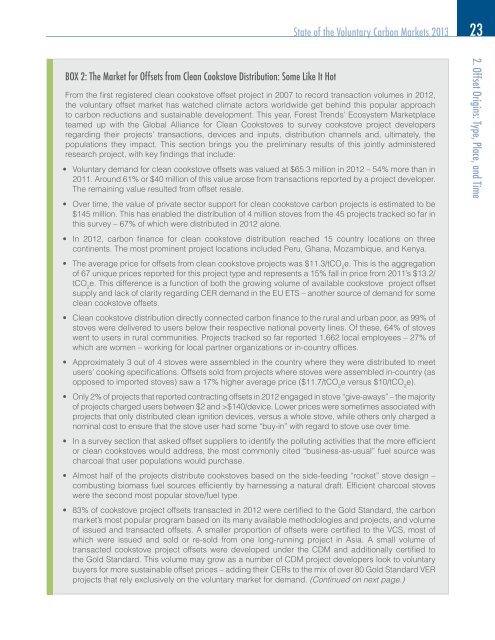Maneuvering the Mosaic: Full Report - Forest Trends
Maneuvering the Mosaic: Full Report - Forest Trends
Maneuvering the Mosaic: Full Report - Forest Trends
You also want an ePaper? Increase the reach of your titles
YUMPU automatically turns print PDFs into web optimized ePapers that Google loves.
BOX 2: The Market for Offsets from Clean Cookstove Distribution: Some Like It Hot<br />
State of <strong>the</strong> Voluntary Carbon Markets 2013 23<br />
From <strong>the</strong> fi rst registered clean cookstove offset project in 2007 to record transaction volumes in 2012,<br />
<strong>the</strong> voluntary offset market has watched climate actors worldwide get behind this popular approach<br />
to carbon reductions and sustainable development. This year, <strong>Forest</strong> <strong>Trends</strong>’ Ecosystem Marketplace<br />
teamed up with <strong>the</strong> Global Alliance for Clean Cookstoves to survey cookstove project developers<br />
regarding <strong>the</strong>ir projects’ transactions, devices and inputs, distribution channels and, ultimately, <strong>the</strong><br />
populations <strong>the</strong>y impact. This section brings you <strong>the</strong> preliminary results of this jointly administered<br />
research project, with key fi ndings that include:<br />
• Voluntary demand for clean cookstove offsets was valued at $65.3 million in 2012 – 54% more than in<br />
2011. Around 61% or $40 million of this value arose from transactions reported by a project developer.<br />
The remaining value resulted from offset resale.<br />
• Over time, <strong>the</strong> value of private sector support for clean cookstove carbon projects is estimated to be<br />
$145 million. This has enabled <strong>the</strong> distribution of 4 million stoves from <strong>the</strong> 45 projects tracked so far in<br />
this survey – 67% of which were distributed in 2012 alone.<br />
• In 2012, carbon fi nance for clean cookstove distribution reached 15 country locations on three<br />
continents. The most prominent project locations included Peru, Ghana, Mozambique, and Kenya.<br />
• The average price for offsets from clean cookstove projects was $11.3/tCO 2 e. This is <strong>the</strong> aggregation<br />
of 67 unique prices reported for this project type and represents a 15% fall in price from 2011’s $13.2/<br />
tCO 2 e. This difference is a function of both <strong>the</strong> growing volume of available cookstove project offset<br />
supply and lack of clarity regarding CER demand in <strong>the</strong> EU ETS – ano<strong>the</strong>r source of demand for some<br />
clean cookstove offsets.<br />
• Clean cookstove distribution directly connected carbon fi nance to <strong>the</strong> rural and urban poor, as 99% of<br />
stoves were delivered to users below <strong>the</strong>ir respective national poverty lines. Of <strong>the</strong>se, 64% of stoves<br />
went to users in rural communities. Projects tracked so far reported 1,662 local employees – 27% of<br />
which are women – working for local partner organizations or in-country offi ces.<br />
• Approximately 3 out of 4 stoves were assembled in <strong>the</strong> country where <strong>the</strong>y were distributed to meet<br />
users’ cooking specifi cations. Offsets sold from projects where stoves were assembled in-country (as<br />
opposed to imported stoves) saw a 17% higher average price ($11.7/tCO 2 e versus $10/tCO 2 e).<br />
• Only 2% of projects that reported contracting offsets in 2012 engaged in stove “give-aways” – <strong>the</strong> majority<br />
of projects charged users between $2 and >$140/device. Lower prices were sometimes associated with<br />
projects that only distributed clean ignition devices, versus a whole stove, while o<strong>the</strong>rs only charged a<br />
nominal cost to ensure that <strong>the</strong> stove user had some “buy-in” with regard to stove use over time.<br />
• In a survey section that asked offset suppliers to identify <strong>the</strong> polluting activities that <strong>the</strong> more effi cient<br />
or clean cookstoves would address, <strong>the</strong> most commonly cited “business-as-usual” fuel source was<br />
charcoal that user populations would purchase.<br />
• Almost half of <strong>the</strong> projects distribute cookstoves based on <strong>the</strong> side-feeding “rocket” stove design –<br />
combusting biomass fuel sources effi ciently by harnessing a natural draft. Effi cient charcoal stoves<br />
were <strong>the</strong> second most popular stove/fuel type.<br />
• 83% of cookstove project offsets transacted in 2012 were certifi ed to <strong>the</strong> Gold Standard, <strong>the</strong> carbon<br />
market’s most popular program based on its many available methodologies and projects, and volume<br />
of issued and transacted offsets. A smaller proportion of offsets were certifi ed to <strong>the</strong> VCS, most of<br />
which were issued and sold or re-sold from one long-running project in Asia. A small volume of<br />
transacted cookstove project offsets were developed under <strong>the</strong> CDM and additionally certifi ed to<br />
<strong>the</strong> Gold Standard. This volume may grow as a number of CDM project developers look to voluntary<br />
buyers for more sustainable offset prices – adding <strong>the</strong>ir CERs to <strong>the</strong> mix of over 80 Gold Standard VER<br />
projects that rely exclusively on <strong>the</strong> voluntary market for demand. (Continued on next page.)<br />
2. Offset Origins: Type, Place, and Time
















